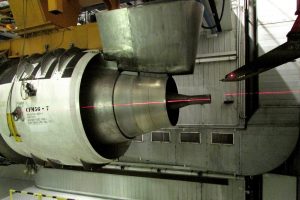Researchers under the leadership of the University of Bern have investigated the effect of exhaust particles from aircraft turbine engines on human lung cells. The cells reacted most strongly to particles emitted during ground idling. It was also shown that the cytotoxic effect is only to some extent comparable to that of particles from gasoline and diesel engines.
According to the World Health Organization (WHO), seven million people worldwide die as a consequence of air pollution every year. For around 20 years, studies have shown that airborne particulate matter negatively affects human health. Now, in addition to already investigated particle sources like emissions from heating systems, industry and road traffic, aircraft turbine engine particle emissions have, in the wake of increasing air traffic, also become more important. As a result, scientific research of the particulate matter from air traffic is important for the development of environmental standards in the aviation sector. However, the toxicity of the solid particles from aircraft turbine engines is still widely unresearched.

Close-up of the turbine engine at the testing facility with the aerosol sampling probe in place (right). Photo: University of Bern /SR Technics Switzerland AG
Now a multidisciplinary team, led by lung researcher Marianne Geiser of the Institute of Anatomy at the University of Bern, together with colleagues from Empa Dübendorf and the University of Applied Sciences and Arts Northwestern Switzerland (FHNW), has shown that primary soot particles from kerosene combustion in aircraft turbine engines also cause direct damage to lung cells and can trigger an inflammatory reaction if the solid particles – as simulated in the experiment – are inhaled in the direct vicinity of the engine. The researchers demonstrated for the first time that the damaging effects also depend on the operating conditions of the turbine engine, the composition of the fuel, and the structure of the generated particles. The present study was published in the journal “Nature Communications Biology”.
Particles emitted from aircraft turbine engines are generally ultrafine, i.e. smaller than 100 nm. By way of comparison, a human hair has a diameter of about 80,000 nm. When inhaled, these nanoparticles – like those from other combustion sources – efficiently deposit in the airways. In healthy people, the well-developed defense mechanisms in the lungs normally take care of rendering the deposited particles ineffective and removing them from the lungs as quickly as possible. However, if the inhaled particles manage to overcome these defense mechanisms, due to their structure or physico-chemical properties, there is a danger for irreparable damage to the lung tissue. This process, already known to researchers from earlier experiments with particle emissions from gasoline and diesel engines, has now also been observed for particle emissions from aircraft engines.
Evidence of increased cell membrane damage and oxidative stress in the cell cultures was identified. Oxidative stress accelerates ageing of cells and can be a trigger for cancer or immune system diseases. The particles turned out to cause different degrees of damage depending on the turbine thrust level and type of fuel: the highest values were recorded for conventional fuel at ground idling, and for biofuel in climb mode.
Bibliographic information:
Jonsdottir HR, Delaval M, Leni Z, Keller A, Brem BT, Siegerist F, Schönenberger D, Durdina L, Elser M, Burtscher H, Liati A, Geiser M.: Non-volatile particle emissions from aircraft turbine engines at ground-idle induce oxidative stress in bronchial cells. Nature Communications Biology. 2:90 (2019), DOI: 10.1038/s42003-019-0332-7





